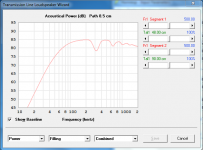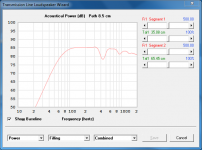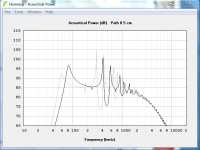I'm planning a set of 3" full range driver transmission line speakers using PVC pipe for the enclosure. Is the calculator below sufficient or is their a better one for this type of enclosure?
Strassacker: Calculators for speaker building
Thanks.
Strassacker: Calculators for speaker building
Thanks.
No, that calculator is “classic” so most often out to lunch in terms of a TL.
What 3” FR are you planning to use?
dave
What 3” FR are you planning to use?
dave
Qts is on the highish side, definitly needs modeling. You might want to look at the Frugel-Horn Lite… it is quite good at extracting maximum bass from this size driver.
dave
dave
I definitely want to stick with PVC. I have built a pair of metronomes with similar drivers that sound good and figured that PVC would facilitate and easy build.
You’ll likely need at least 4” pip. ,aybe 5 or 6 to het sufficient cross-section — but that is just an educated guess.
dave
dave
5 inch PVC would give a cross-sectional area very close to what the TABAQ requires (19.63 cu. inch vs. 19.84. The vent would need to be calculated, but it should work.
TABAQ TL for Tang Band
TABAQ TL for Tang Band
I work for a plumbing distributor. Pipe is not an issue. A good calculator would be a big help though.
I've actually got these Tang Bands in my Metronomes. Is there a current link to the MJK software? The ones I have tried are broken. Making progress. Thanks again.
Well, MJK has had an excellent freeware design routine available since 2006 with another forum member? sharing his Excel SS a few years later to save some of us from having to wade through the instructions and somewhat tedious tables:
http://www.quarter-wave.com/TLs/Alignment_Tables.pdf
http://www.quarter-wave.com/TLs/Alignment_Tables_Calculator_3_3_09.xls
GM
http://www.quarter-wave.com/TLs/Alignment_Tables.pdf
http://www.quarter-wave.com/TLs/Alignment_Tables_Calculator_3_3_09.xls
GM
You’ll likely need at least 4” pip. ,aybe 5 or 6 to het sufficient cross-section — but that is just an educated guess.
dave
FWIW, a quick Hornresp TL sim based on an IB's > 10x Vas yields a +/- 3 dB [normally good enough in room for all but the 'golden eared'] down to ~62 Hz/Fs impedance tuning [Fp] with a modest amount of evenly distributed polyfil stuffing.
3" - 7" i.d. pipes sim acoustically too close in the bass to matter, though the largest does have a bit less mid band 'ripple', but by stuffing to 'taste', my SWAG is that the 5" based a ~10x Vas should allow sufficient tuning adjustment without risking 'choking' the driver from too high a stuffing density.
Regardless of pipe diameter: 54.33"/138 cm i.d. long, driver offset = 18.9"/48 cm i.d. spaced up off the floor a little puts the driver at the popular ~38" seated ear height.
GM
Attachments
I just ran calcs based upon the alignment tables excel sheet and cam up with the following:
Re 6.8
Fs 82
Qts 0.63
Sd 30.2
Bl 3.5
SL/SO 1
Area of open/closed end 17.04"
Actual length 39.58
Any thoughts on the delta between this and GMs Hornresp calculated length?
Re 6.8
Fs 82
Qts 0.63
Sd 30.2
Bl 3.5
SL/SO 1
Area of open/closed end 17.04"
Actual length 39.58
Any thoughts on the delta between this and GMs Hornresp calculated length?
Note that HR only calculated what I inputted, same as any other box design program; my design is based on T/S specs where a max flat alignment is when Fb = Fs, Vb = Vas, Qts' = ~0.403 from this basic formula: Vb = 20*Vas*Qts'^3.3
Qts' = Qts + any added series resistance [Rs]: HiFi Loudspeaker Design
From this we see that when Qts' is < ~0.403: Fb > Fs, Vb < Vas and vice versa when > ~0.403 [Fb < Fs, Vb > Vas], so with the PC83's ~0.63 + wiring losses, Fp < Fs, Vb > Vas and what my alignment is based on whereas MJK ignores this and tunes to actual Fs [the pioneer's choice], so his is shorter, 'fatter' and has a bit less net bulk with the trade-off that with the same percentage [optimum] driver offset requires more work to get it up to ear height.
Consequently, mine has a lower Q ['slower'] roll off below its mass corner [2*Fs/Qts' = ~246 Hz] that usually blends better overall in room than his max flat/4th order slope, requiring more stuffing to match it [assuming you wanted to], so in this case it seems more about which one you prefer to build for whatever reason since any performance differences is stuffing density dependent.
Then again, some folks would prefer the shorter, 'fatter' pipe's potentially > 'thump' in the mid-bass as shown in HR's 'raw' comparison depending on what type, how much and where in the pipe, stuffing is put.
GM
Qts' = Qts + any added series resistance [Rs]: HiFi Loudspeaker Design
From this we see that when Qts' is < ~0.403: Fb > Fs, Vb < Vas and vice versa when > ~0.403 [Fb < Fs, Vb > Vas], so with the PC83's ~0.63 + wiring losses, Fp < Fs, Vb > Vas and what my alignment is based on whereas MJK ignores this and tunes to actual Fs [the pioneer's choice], so his is shorter, 'fatter' and has a bit less net bulk with the trade-off that with the same percentage [optimum] driver offset requires more work to get it up to ear height.
Consequently, mine has a lower Q ['slower'] roll off below its mass corner [2*Fs/Qts' = ~246 Hz] that usually blends better overall in room than his max flat/4th order slope, requiring more stuffing to match it [assuming you wanted to], so in this case it seems more about which one you prefer to build for whatever reason since any performance differences is stuffing density dependent.
Then again, some folks would prefer the shorter, 'fatter' pipe's potentially > 'thump' in the mid-bass as shown in HR's 'raw' comparison depending on what type, how much and where in the pipe, stuffing is put.
GM
Attachments
PVC as the most toxic plastic, and vinyl chloride, the chemical used to make PVC, has been described as a known carcinogen by the World Health Organization's International Agency for Research on Cancer.I definitely want to stick with PVC.
- Status
- Not open for further replies.
- Home
- Loudspeakers
- Full Range
- PVC TL enclosure calculations


